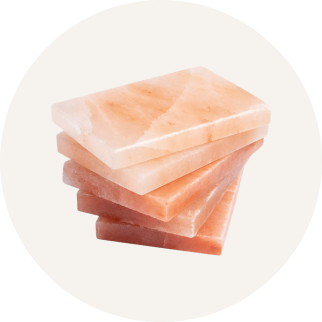Himalayan Salt cooking blocks have become popular among food enthusiasts for their unique ability to impart a delicate yet rich flavor to various dishes. This article will guide you through using these exquisite Himalayan salt blocks to elevate your culinary creations.
First-time Use of Salt cooking blocks

Using salt cooking blocks for the first time requires careful preparation to ensure a successful cooking experience. Select high-quality Himalayan salt blocks from Himalayan Pink Salt for their unique flavor. Before cooking, it is crucial to season the salt block correctly. Please place it in a cold oven or grill and gradually increase the temperature over an hour, allowing the Himalayan salt block to acclimate and avoid cracking. Once seasoned, you can start with simple recipes like grilled vegetables or thinly sliced meats. Heat the Himalayan salt blocks gradually to prevent thermal shock, reaching the desired cooking temperature. Lightly oil the salt cooking block or brush oil onto the food to prevent sticking. When cooking, be attentive to prevent over-salting. The salt cooking block imparts a delicate saltiness to the food, so additional seasoning may not be necessary. After use, cleaning the salt cooking block is essential. Avoid using water; scrape off residue with a brush or spatula. Proper care, seasoning, and gradual heating are critical to maximizing the benefits of salt cooking blocks, ensuring a flavorful and memorable culinary experience.
Oil on Salt Cooking Block
Adding oil directly to the salt cooking block is generally unnecessary when using salt cooking blocks. Cooking on Himalayan salt blocks imparts a subtle, savory flavor to the food while providing a unique cooking surface. Himalayan Salt blocks can retain and distribute heat well and evenly, making them ideal for grilling or searing various ingredients. However, to prevent sticking and ensure a smooth cooking experience, we recommend oiling the food before placing it on the salt cooking block. Brushing or marinating the ingredients with a light coat of oil can help create a barrier between the food and the salt cooking block, reducing the risk of sticking. Additionally, using oil with a high smoke point, such as grapeseed or vegetable oil, is advisable to avoid any undesirable flavors or burning during cooking. The goal is to develop the food's natural flavors and benefit from the unique properties of the salt cooking block without overpowering the dish with additional oil.
Himalayan Salt Blocks: Subtle Flavor
Cooking on the Himalayan salt blocks can impart a subtle, nuanced flavor to food without necessarily making it overly salty. The salt cooking block, typically made of Himalayan Salt, slowly imparts a mild saltiness to the food as it cooks. The process involves the transfer of minerals and trace elements from the salt cooking block to the food, enhancing its taste. The key to avoiding excessive saltiness lies in proper preheating and temperature control. Gradually heating the salt cooking block allows it to distribute heat evenly and infuse the food with a delicate salt flavor.

Moreover, choosing the right ingredients and adjusting seasoning help balance the overall taste. It provides a unique cooking experience, imparting a hint of saltiness and creating a visually appealing presentation. As with any cooking method, experimentation and careful attention to the cooking process contribute to achieving the desired balance of flavors without overpowering saltiness.
Cleaning of Salt Cooking Block after Cooking
After cooking on a salt cooking block, cleaning is essential to maintain its integrity and hygiene. The procedure is simple. Start by allowing the salt cooking block to cool completely. Avoid using water on a hot salt cooking block, as rapid temperature changes can cause it to crack. Once cool, gently scrape off any food remnants with a soft brush or spatula. Avoid using soap or detergent, as the salt cooking block can absorb these substances, affecting the flavor of future dishes. For more stubborn residues, lightly dampen a sponge or cloth with water and softly scrub the surface. Be cautious to keep the Himalayan salt block manageable, as excessive moisture can lead to erosion over time. After cleaning, let the Himalayan salt block air-dry thoroughly before storing it. Proper storage is essential to prevent the growth of mold or mildew. Store the salt cooking block in a dry place, and cover it with a cloth or place it in a sealable bag to protect it from dust. Regular maintenance, proper cleaning, and careful storage will ensure the longevity of your salt cooking block, allowing you to continue enjoying the unique flavors it imparts to your culinary creations.
Conclusion
In conclusion, using Himalayan salt cooking blocks has transcended mere culinary trends, becoming a staple for those seeking a distinctive and interactive approach to cooking and dining. From imparting subtle flavors to providing an aesthetically pleasing presentation, these Himalayan salt cooking blocks continue to captivate home cooks and professional chefs alike, offering a touch of the Himalayas to kitchens worldwide.

